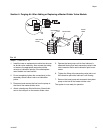
Setup
312497P 3
Pressure Relief Procedure
Follow the Pressure Relief Procedure whenever
you see this symbol.
1. Verify pump feeding valve is stopped and discon-
nected from, or locked out of it’s driver.
2. Using a wrench, slowly loosen inlet nut.
3. Then, using a wrench, slowly loosen each port nut.
Setup
The divider valve is shipped ready to install in your sys-
tem. It has been factory-tested and should not require
any additional modification.
For MJ and MX series valves only
: Gaskets (a) must be
installed between every valve section (b) of the block
assembly to prevent leaking.
To install the divider valve in your system:
1. Determine an appropriate, remote mounting loca-
tion.
2. Install a rupture to atmosphere fitting with a blow-out
disk that is rated for 7,500 psi (52 MPa, 517 bar) or
less between the force feed lubricator pump and
master divider valve inlet.
3. Install an analog pressure gauge at the inlet to the
divider valve.
4. Install a slow or no cycle shutdown in one of the pis-
ton enclosure plugs. Program it to shut down after
no more than 180 seconds without a complete
cycle.
5. Torque. See Table 4 on page 15.
As long as lubricant is supplied under pressure to the
inlet section of the divider assembly, valves sections will
continue to operate in a progressive manner. Divider
assemblies always follow a constant discharge pattern.
Whenever lubricant flow ceases, the valving pistons will
stop. When flow resumes, it will start again at the same
point in the discharge cycle.
This equipment stays pressurized until pressure is
manually relieved. To help prevent serious injury
from pressurized fluid, such as skin injection,
splashing fluid and moving parts, follow the Pressure
Relief Procedure when you stop spraying and before
cleaning, checking, or servicing the equipment.
FIG. 1
a
b
b
NOTICE
Do not install a divider valve into a system rated for
more than the valve’s maximum operating pressure.
This type of installation could result in o-ring damage
and cause the divider valve to leak.


















